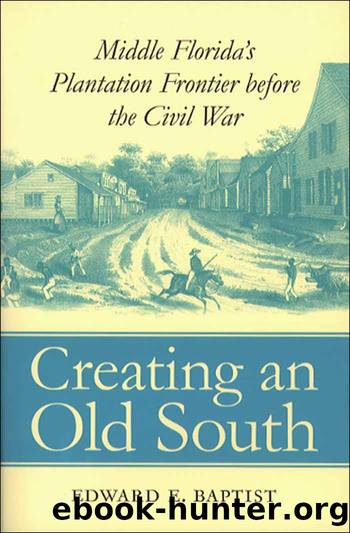Creating an Old South by Edward E. Baptist

Author:Edward E. Baptist [Baptist, Edward E.]
Language: eng
Format: epub
Tags: History, United States, 19th Century, Social Science, Ethnic Studies, American, African American & Black Studies, State & Local, South (AL; AR; FL; GA; KY; LA; MS; NC; SC; TN; VA; WV)
ISBN: 9780807860038
Google: BabqCQAAQBAJ
Publisher: Univ of North Carolina Press
Published: 2003-04-03T02:58:49+00:00
FAMILY AND FRONTIER HISTORY AT EL DESTINO
In 1835, a man named John Walker was moved from Culpeper County, Virginia, to Leon County. He was forced to leave behind his first wife and two children. Separated from his family, he remarried. Was this because, as slaveowners sometimes claimed when breaking up African Americansâ families, people like John Walker simply did not care much about family and thus were not as devastated by such divisions as whites would themselves have been? The evidence suggests that Walker never forgot those whom he had been forced to leave behind. Through messages passed along by later enslaved migrants from the Culpeper area, Walker kept up with his Virginia family, and learned that one of his children had died. But Walker, like countless others, had to choose between despair and rebuilding. His remarriage was not desertion but an attempt to adapt to circumstances beyond his control.2 Once brought to the Middle Florida frontier, African Americans like John Walker were able to create new families and kinship networks despite disease, separation, and distorted demographic structures. By the late 1830s, unfree migrants were also overcoming whatever cultural distinctions existed between the different groups of slaves brought to Jackson and Leon Counties. Rebuilt families in brand-new quarters could not entirely replace what had been lost, nor erase the painful scars of separation, but most enslaved African Americans doggedly endured the emotional pain of removal. From old and new family ties and marriages, from âfictiveâ and ârealâ kin, they pieced together new webs of kinship and community. Such accomplishments were difficult tasks indeed, as the example of African American life on El Destino plantation suggests.
During the 1830s and 1840s, Leon Countyâs El Destino plantation was owned successively by William Nuttall, his widow Mary Nuttall, and then her second husband, George Noble Jones. Nuttall, from Virginia, launched the plantation in 1828, bringing forty slaves from Virginia to clear land at a site on the eastern border of Leon County. His list of the first forty grouped these individuals into seven households (see Table 7.1). Two of them, those headed by Isham and his wife, Mary Isham, and Pleasant and Betty, were two-parent households.3 Three, including the ones headed by Kate and Phillis, and what appears to be one headed by Sim, had only one parent presentâat least once these families were actually brought south. Six men composed another household: each was probably stripped, regardless of existing family ties, from slave auctions or the Nuttall familyâs holdings. The final migrant, Temp, later the mother of several El Destino slaves, appears to have been a single female living on her own.4
Download
This site does not store any files on its server. We only index and link to content provided by other sites. Please contact the content providers to delete copyright contents if any and email us, we'll remove relevant links or contents immediately.
Cecilia; Or, Memoirs of an Heiress — Volume 1 by Fanny Burney(32004)
Cecilia; Or, Memoirs of an Heiress — Volume 3 by Fanny Burney(31428)
Cecilia; Or, Memoirs of an Heiress — Volume 2 by Fanny Burney(31371)
The Great Music City by Andrea Baker(30621)
We're Going to Need More Wine by Gabrielle Union(18586)
All the Missing Girls by Megan Miranda(14529)
Pimp by Iceberg Slim(13694)
Bombshells: Glamour Girls of a Lifetime by Sullivan Steve(13656)
Fifty Shades Freed by E L James(12874)
Talking to Strangers by Malcolm Gladwell(12797)
Norse Mythology by Gaiman Neil(12751)
For the Love of Europe by Rick Steves(11311)
Crazy Rich Asians by Kevin Kwan(8846)
Mindhunter: Inside the FBI's Elite Serial Crime Unit by John E. Douglas & Mark Olshaker(8649)
The Lost Art of Listening by Michael P. Nichols(7105)
Enlightenment Now: The Case for Reason, Science, Humanism, and Progress by Steven Pinker(6844)
The Four Agreements by Don Miguel Ruiz(6271)
Bad Blood by John Carreyrou(6245)
Weapons of Math Destruction by Cathy O'Neil(5779)
